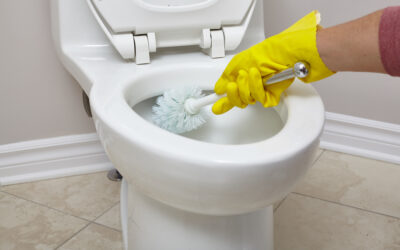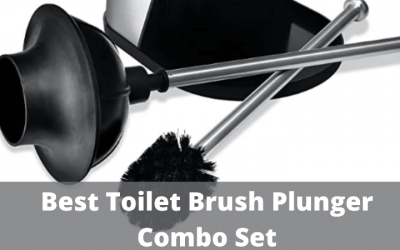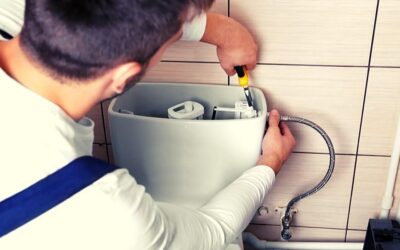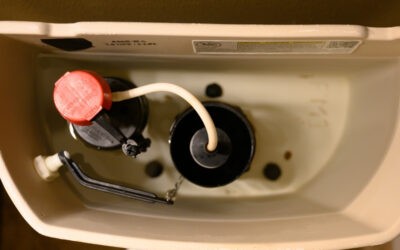In this article, we will talk about how to clean toilet tank with vinegar and baking soda.
The toilet tank is one of the most overlooked parts of a bathroom. It’s usually ignored during cleaning yet it easily accumulates bacteria and hard water stains.
A little bit of care goes a long way with keeping your home healthy and free from any harmful contaminants.
One of the cheapest and easiest ways to clean the tank is with vinegar and baking soda. Both are excellent cleaning products that will break up any hard water residue and get rid of smells. Vinegar is an acid that will cut through limescale and mineral deposits in your toilet tank, while baking soda acts as a natural scrubber.
Key Takeaways
- Materials Needed: 1 cup vinegar, ¼ cup baking soda, toilet brush, optional dish soap.
- Step 1 – Empty Water: Flush the toilet and open the drain valve to empty the tank. Turn off the water valve to stop water inflow.
- Step 2 – Vinegar Addition: Pour 1 cup of vinegar (preferably white distilled or unfiltered/raw) into the tank. Vinegar is cost-effective and safe, helping to break down buildup.
- Step 3 – Add Baking Soda: Add ¼ cup baking soda to the tank. Baking soda acts as a natural scrubber.
- Step 4 – Scrubbing: After letting the mixture sit for a few hours, scrub the inside of the tank with a toilet brush or toothbrush, focusing on crevices and hard water lines.
- Step 5 – Rinse and Flush: Open the water valve, let the tank fill, and flush. Repeat if necessary.
- Frequency: It’s recommended to repeat this cleaning process every 3 months.
Steps on how to clean toilet tank with vinegar and baking soda
Cleaning your toilet tank with vinegar and baking soda is one way to keep it smelling fresh. We’ve outlined the process below, but first, you will need; 1 cup vinegar, ¼ cup baking soda, toilet brush, dish soap (optional).
The following are the steps to follow when cleaning with baking soda and vinegar.
Step 1: Empty the water in the toilet tank
The first step is removing any water from the tank by flushing the toilet and then opening up the drain valve at the bottom of the tank.
Next, turn off the water valve so that no more water comes into the tank.
Step 2: Pour 1 cup of vinegar into the toilet tank
The second step is to pour 1 cup of vinegar into the tank. White distilled vinegar or unfiltered or raw vinegar is preferred.
The good thing about vinegar is that it is a cost-effective alternative to harsh toilet cleaners and it will help to break down any buildup and leave your toilet tank smelling fresh.
In addition, it is completely safe to use it with other household cleaning products like baking soda for maximum effectiveness as explained in the next step.
Step 3: Add ¼ cup baking soda
The third step is to add a ¼ cup of baking soda into the tank. Baking soda is also a cost-effective alternative to harsh cleaning solvents. Using it will help to break up any hard-to-reach gunk inside the toilet tank.
Mix the baking soda and vinegar in the tank and then let the mixture sit for a few hours for the reaction to take effect.
Step 4: Scrub the inside of the tank with a toilet brush
After a few hours, it’s time to scrub the tank.
Start scrubbing inside the tank using a clean toilet brush or toothbrush. Pay extra attention to the crevices and the hard water line or marks around the tank.
This will help to get rid of the stains as well as build up in the water.
Step 5: Rinse and flush the toilet
The last step is to open the valve so that water can get into the tank and then flush down the toilet.
It may be a good idea to use a plunger after cleaning out the water so that you can get all of the gunk off from inside the bowl, but this is not necessary if it doesn’t seem like there’s too much built up on your walls.
Repeat if necessary, or add more baking soda as needed and then scrub and flush again after waiting a few minutes. Clean up any residue left behind with water and a paper towel
To keep the toilet tank clean and prevent build-up, it is recommended to repeat this process every 3 months.
See also: How to break down toilet paper clog
More toilet tank cleaning hacks
1. Use toilet tank cleaner tablets
Other than vinegar and baking soda, you can use toilet tank cleaner tablets. The tablets are safe to use since they contain sodium bicarbonate. Sodium bicarbonate has been used for many years to help clean out the pipes and other plumbing fixtures without any adverse effect on health or safety.
Toilet tank cleaner tablets are easy enough to find at most major retail stores both physical and online. For instance, you can get this Vacplus Toilet bowl cleaner tablets that help to get rid of limescale, urine, and rust stains in the toilet tank and bowl.
They also help to remove pungent smell in the toilet and with every flush; the tablets form a protective layer on the bowl that prevents stains from hard water.
Toilet tank cleaners don’t contain any harsh chemicals so there is no worry if small children come into contact with them. They’re affordable too which makes buying more than one box an even better idea.
See also: What causes grey stains in toilet bowl?
2. How to clean toilet tank with coke
This is an easy DIY that will save you money as well as avoid the use of expensive chemical cleaning products. Coke is effective in cleaning because it eats away at the buildup caused by minerals in hard water and grime.
To clean the tank, pour one liter of cola (or 2 cans) down the tank followed by 1 tablespoon white vinegar or baking soda. Let it sit for about 10 minutes before flushing everything away. You should be left with a clean, shiny toilet bowl as well as fresh smelling bathroom all thanks to Coca-Cola.
See also: Why does poop stick to toilet bowl
Conclusion
The toilet tank is the area where most of your icky, gross buildup will accumulate and you’ll never want to see. While cleaning your toilet tank with vinegar and baking soda is a great DIY solution for maintaining hygiene and preventing buildup, sometimes your plumbing needs might extend beyond simple maintenance. If you encounter persistent issues, complex problems, or simply prefer a professional touch, don’t hesitate to seek help from a local toilet plumber. They can provide you with more comprehensive solutions, ensure your plumbing system is functioning optimally, and offer advice tailored to your specific needs. Choose Best Plumbers Club to connect with reliable, skilled plumbers in your area. Remember, a well-maintained plumbing system is key to a happy and healthy home!











